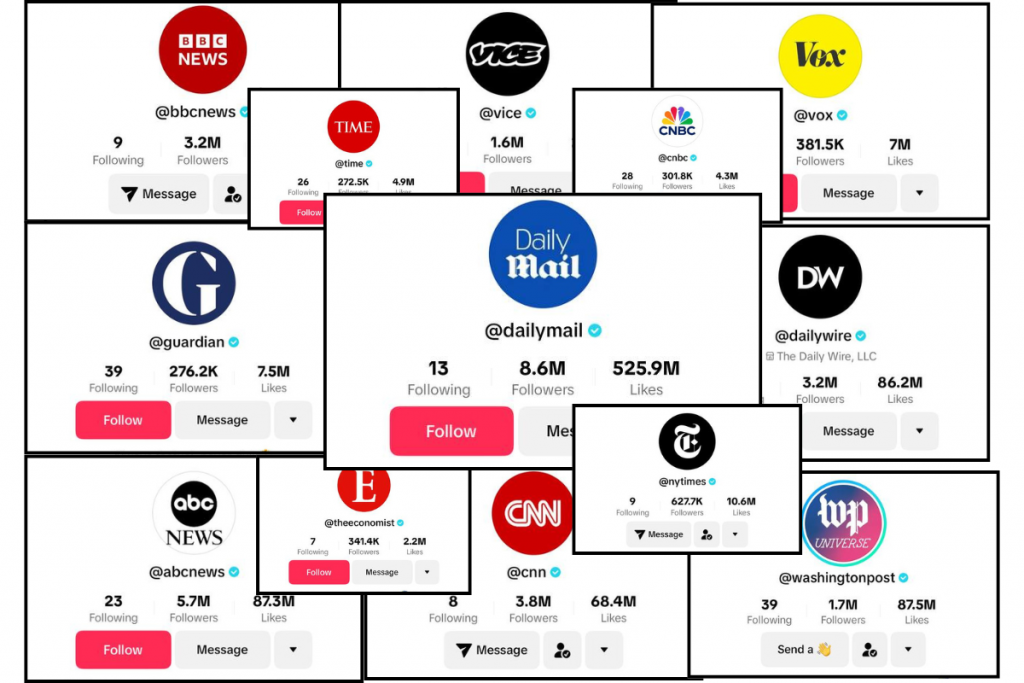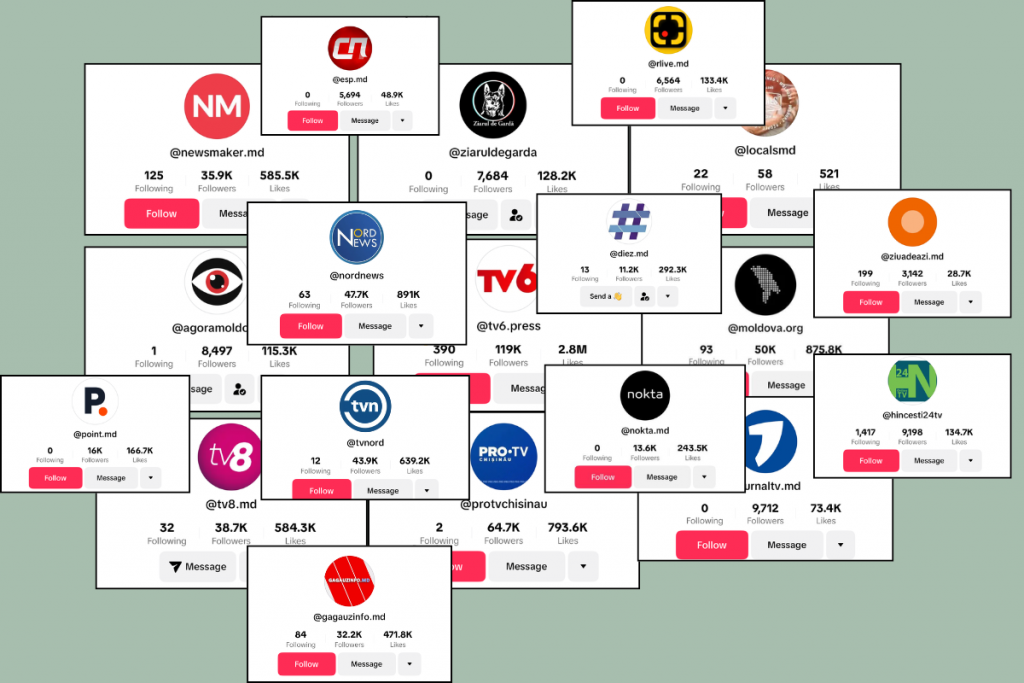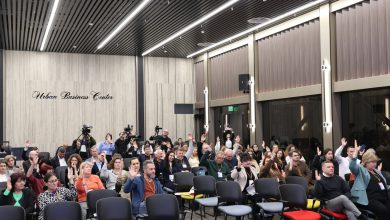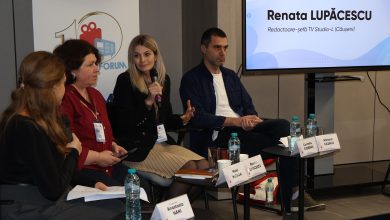To Be or Not to Be on TikTok: In the Republic of Moldova, the Press Explores the Application and the Strategies to Be Applied by the Newsrooms
Felicia Nedzelschi

More than 1 billion of the globe’s inhabitants actively use TikTok on a monthly basis. In the current reality, many journalists adapt to the popularity of this platform, creating special content and trying to figure out its background issues such as fakes, algorithms, and the users’ extremely short attention span. Media Azi analyzes how some media outlets in the Republic of Moldova cope with these tasks. Which newsrooms have TikTok pages, what do their videos look like, and how many followers do they have? We have also tried to find out what the press can lose or gain in the TikTok era, what the strategies of the newsrooms are, and which goals they pursue while using the app.
Launched in 2016 in China as Douyin and globally in 2017, known as TikTok, the application has had a rapid rise, currently registering one billion active users per month. According to the statistics, they spend up to an hour and a half a day using the app. In 2022, Business Insider wrote that almost half of Generation Z users use TikTok and Instagram as search engines instead of Google. Moreover, the Pew Research Center discovered that, in just three years, the share of US adults who regularly watch news on TikTok has increased more than four times, growing from 3% in 2020 to 14% in 2023. About a one-third of Americans aged 18-29 (32%) say TikTok is the channel they regularly use to find out the news.
Western Journalists and TikTok
In late 2022, the Reuters Institute for the Study of Journalism wrote that half of the world’s top publications appeared on TikTok, and the Publishing Trends Report 2023 mentions that, last year, 59% of newsrooms surveyed regarded TikTok as an important platform, and the rate of this response was 39% higher than the previous year. The Nieman Foundation for Journalism at Harvard University compiled a periodically revised list of journalists and media platforms present on TikTok. It currently includes almost 900 names.
In recent years, such media giants as BBC, CNN, ABC News, Daily Mail, Washington Post, etc. have attracted enormous numbers of followers on the platform. At the moment this article was written, the Daily Mail had 8.6 million followers. For comparison, the most popular TikToker, Khaby Lame, has 161.8 million followers.
To stand out and to post more attractive content on TikTok, foreign newsrooms adopt various strategies – from short videos adapted from video content already produced for their own websites to original content created especially for the platform. The Washington Post is a prominent example of the latter strategy, with 1.7 million followers. The media outlet started with one person, Dave Jorgensen, in 2020, and currently, it has three content creators. The page is a mixture of humor, explainers, sketches, and serious information explained in a funny way, acting, music, and parodies. In this way, a newspaper with a history of over 140 years tries attracting new audiences and sources of income.

The Washington Post as an example is also special because it features persons who tell the news and provide interactive content, unlike CNN which distributes video from its own newscasts on TikTok, with text placed on the image. But the audiences CNN, the Washington Post, or the Daily Mail have gathered cannot compare to that of a user named Dylan Page who has 10 million followers. Page calls himself “News Daddy” and the description of his page says it is “No 1 news account on TikTok.” In all of his videos, Page can be seen in the footer of the image, commenting on the news taken from the media, entertainment press, or viral stories; he is not involved in actual journalistic activity. His success is explained by the Reuters Institute for the Study of Journalism which affirms that audiences on all platforms want to consume the content from “personalities” to the detriment of mainstream news accounts, and this tendency can be noticed not only on TikTok, but also on YouTube or Instagram.
Both Reuters and Nieman Lab emphasize that, as a result, users were rarely recommended media pages. Nieman Lab also mentions that “news won’t find you on TikTok,” which seems to be a paradox of the platform as long as surveys reveal how many users, especially young people, prefer using this application for information.
The News Experiment on TikTok
The Nieman Lab draws attention to a study published in the New Media & Society magazine. Two researchers, Nick Hagar and Nicholas Diakopoulos, developed some intelligent ways to analyze the role of news within the TikTok algorithm. The researchers analyzed what TikTok recommended to them in terms of news after they had followed four major American news outlets. Starting from the four institutions, they subscribed to another 10000 accounts following the recommendation algorithm.
Later on, the researchers set up 60 bots programmed to detect and determine whether certain videos on the “For You” page deserved to be watched or ignored. Some of the bots were specifically developed by the researchers to be interested in news. The bots watched more than 6.500 videos suggested by TikTok. The result demonstrated that only six videos out of 6568 could be classified as news, and these were two different videos presented more than once.
Moldovan Press on TikTok
In March 2024, the results of a survey conducted by the iData company revealed that 52% of those surveyed had no or little trust in Tiktokers, and another 26% said they had a medium, high, or very high level of trust. The audience in Moldova is substantially smaller compared to the Western one, but there are also media outlets using the platform.

Ana Gherciu, Moldova.org executive director, says that she understands the reason for the reluctance of the media to be on TikTok, because she also used to have the same feelings. Three years ago, however, she decided to take the try this method, and currently, the newsroom’s account has 50000 followers. “I guess the basic reason for reluctance is the first interactions with the app. When you create your account and your feed is not personalized yet, the application suggests the content from the geographical area where you are located and in the language set in the application. We still don’t have very good content creators, and for this reason, newcomers see that the content is of a really poor quality. They have an impression that TikTok is a useless application wasting their time, but later, when you customize your feed and subscribe to whoever you want, you can use it as an application that quickly provides any sort of information,” the journalist says.
To start using TikTok, the Moldova.org newsroom was motivated by success stories from the West. The team drafted a content plan, and in 2021, they hired Ecaterina Buruiana, who was an intern at that point, and who currently runs the outlet’s account. From the very start, the newsroom planned to post at least one video per day. “Most of the content on our account is created exclusively for this platform, and this is actually the only way you can develop on TikTok. It also helps us gather a really diverse community around Moldova.org,” Ecaterina says. Ana Gherciu agrees with her colleague and claims that the media outlets which only duplicate their content from YouTube on TikTok have less chance of going viral.
Ecaterina says it is difficult to break the algorithms when you act as a media outlet. “When you create content from the perspective of a media outlet which has its own editorial policy, values, and obligations to comply with Code of Ethics, you can’t create the content which is most easily accessible to the public, I mean satire, sensational content, etc. What we practice, and what I can recommend, is to have a very clear idea of what niche the content you create occupies, as it helps creating an identity and getting loyal followers. Besides, regularity conquers everyone,” she adds. She recommends that a newsroom using TikTok have its visual identity, tone, and good video editing. “You’ll also need to create more content based on actuality and which refers to the society’s most pressing issues,” Ecaterina considers.
Although in the Republic of Moldova, TikTok videos are not monetized, Moldova.org managed to transform their account into a commercial offer. “Since we created a Tik Tok account, the services we can offer to our customers include creating content for the platform. (…) In my opinion, the press loses its audience if it has no account on TikTok, and it also loses an additional offer it could make available to prospective partners or customers,” Ecaterina Buruiana concludes. “I understand it takes a lot of effort to stay on TikTok, but we need to be there, especially among the persons who, with minimal effort, cause a lot of damage to our journalistic work,” Ana Gherciu adds.
Valeria Batereanu, the Diez.md website editor-in-chief, has taken care of the newsroom’s TikTok since she worked as SMM manager. She admits she hesitated for a while, but currently, Diez has more than 11000 followers. “In the beginning, we had no other strategy than making as many videos as possible. We published one video per week at the most (which I currently understand was not enough). After that, we started doing more and more videos about education. The strategy was talking about education as much as possible, and it proved to be effective. It was more difficult to understand what becomes successful, what the format is, and it was a kind of spontaneous learning. We tried making memes, we tried making some funny stuff, and finally, we ended up doing what we’re all about – education. Yet, anyway, we still keep learning,” Valeria says.
Nowadays, the Diez.md newsroom has a social media strategy; it has specific topics to cover and different tactics for various networks. “I think what journalists can do is to analyze the platforms thoroughly and continuously, and to stay flexible and eager to face any challenges. To realize what users need, you have to walk in their shoes, to understand why they enter the platform, what your audience would like to see there and, just as importantly, in what way they would like to consume the materials,” Valeria Batereanu says.
What Do Newsrooms Which Aren’t on TikTok Miss?
The content distributed on Moldovan TikTok is still “poor, uninspired, and repetitive, largely due to a lack of competition between content creators,” according to Ana Vinogradova, head of the social media department of the ADCENTER digital marketing company. As to the media activity on TikTok, she regards it as an experiment with a wider variety of visual formats; she thinks one should post frequently, at least once a day, and ideally, even four times a day, in order to “beat” the platform’s algorithms.
“It would be desirable to post short, easy-to-watch videos which use the visual and narrative language specific to TikTok, such as effects, top music, and quick montage – they are very efficient today. Since many users prefer visual content, media outlets can use impressive images, animated graphics, and concise text to convey a story. Visual storytelling simplifies and clarifies complex topics. It is essential to prioritize the plots which resonate with the audience they actually intend to attract on TikTok,” the specialist recommends.
Although the platform really seems to be not very suitable for posting news, Ana Vinogradova says it can reach users via directly sharing news among friends or acquaintances by direct messaging, following news portal accounts on TikTok, local virality, and content authenticity. “Once TikTok detects your interest in a certain type of content, it will show it 2-5 times a day to test if you’re really interested in it. If you don’t react to it or skip such videos, the algorithm will understand it and show it to you less often or even remove this sort of content from your feed,” Vinogradova explains.
According to her, some newsrooms’ reluctance to use this platform could result in losing the younger part of their audience. “The opportunity to influence public opinion in various spheres such as technology, food, climate change, etc. may also be lost. In my opinion, if you decide to produce content for TikTok, you have to act consistently, and it should be adapted to the platform’s current trends. Daily distribution of a video which conforms to the trends on TikTok is already a good start,” Ana Vinogradova says.




